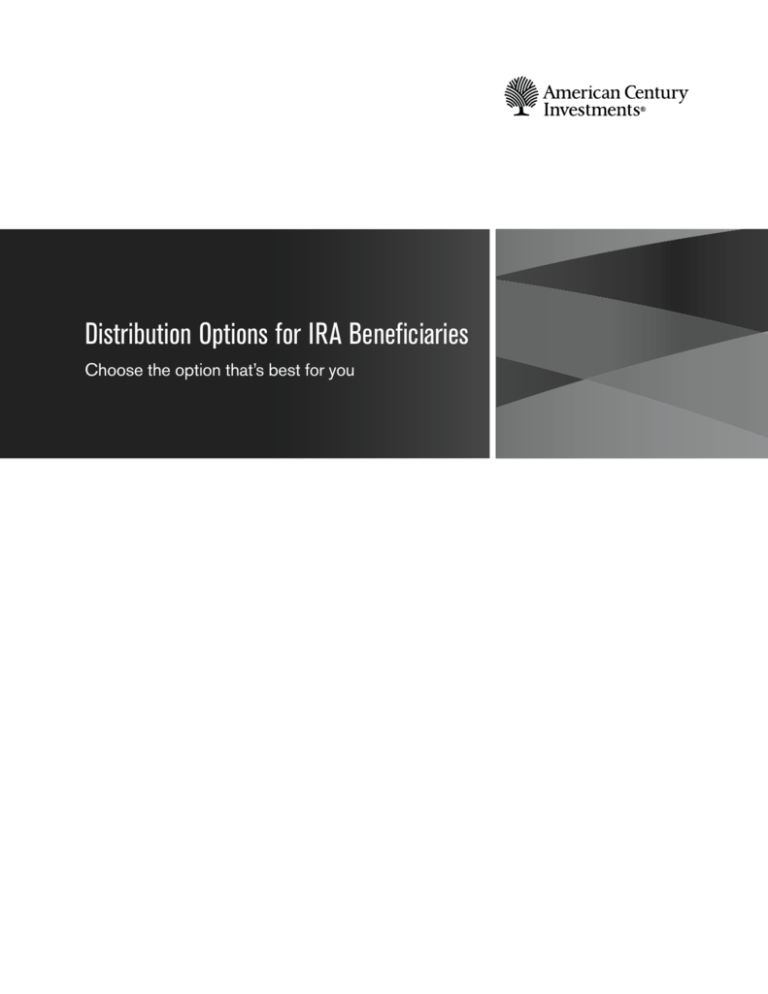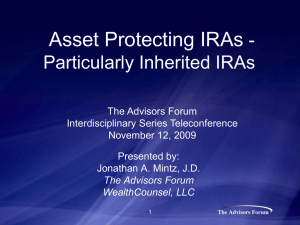
Distribution Options for IRA Beneficiaries
Choose the option that’s best for you
Let Us Help You Make An Informed Decision
Before you begin
Identify your situation:
It’s important to understand your choices and the best options as
the beneficiary of an IRA. The legacy you’ve been given provides
you an opportunity to grow tax-deferred money.
Find the IRA type first, then turn to the page that
describes your beneficiary status.
The death of a loved one is a difficult time. We encourage
you to make decisions in a timely manner as in many
cases a withdrawal is required the year after death to
avoid tax penalties.
Get started
1. Provide information and we’ll transfer the assets
If you haven’t already done so, please provide a copy of a
certified death certificate or other acceptable proof of death.
We may also require other documents. If you received an
estate transfer packet, review the included checklist. If not,
please call us with any questions you may have.
When we have received the document(s), we will transfer the
assets to a beneficiary account(s), registered in your name
and tax ID. This keeps your inherited assets separate from
other assets, because special IRS rules apply.
Options for Beneficiary Traditional, Rollover, SEP,
SARSEP and SIMPLE IRAs
Spouse Beneficiary 2
Non-Spouse Beneficiary 3
Non-Individual Beneficiary* 3
Options for Beneficiary Roth IRAs
Spouse Beneficiary 4
Non-Spouse Beneficiary 5
Non-Individual Beneficiary* 5
IRS Guidelines
Required minimum distributions 6
Tax implications
6
Single life expectancy factor
6
* If a trust qualifies as a pass through or bypass trust, the beneficiaries
may have different options. Call us for details.
2. Review options and provide your instructions
You have several choices for managing the assets you’ve
inherited. Options are listed on the following pages and
depend on your relationship to the decedent and the type
of IRA he or she owned. Also consider:
• Your age.
• The original IRA owner’s age and whether he or she was
taking required minimum distributions (RMDs). RMDs are
the minimum amounts the IRS requires IRA owners to
withdraw each year. They do not apply to Roth IRAs for
the original owner.
• How soon you intend to use the money.
• Your potential tax liability.
Whether you withdraw the money over time or take it all
at one time, you will generally owe taxes when you begin
withdrawals. You may need to include the withdrawals as
taxable income on your tax return in the year you take them.
See page 6 for more details.
When you have decided on an option, complete and return
the appropriate instruction form.
3. Let us help you meet your goals
After the assets are transferred to you, whether in a
beneficiary account or your own IRA, they will remain invested
in the same portfolio that the decedent had. We encourage
you to review the portfolio with one of our representatives to
ensure it fits your own personal investing goals.
Please see page 6 for more details about IRS rules.
1
Our Estate Transfer Team is here to help answer
questions about your options. Call a member of
the team at 1-800-422-3301.
Options for Beneficiary Traditional, Rollover, SEP, SARSEP and SIMPLE IRAs
Determine the required beginning date for the decedent. This is the date the IRS requires the decedent to take minimum
distributions (RMDs)—typically April 1 the year after he or she turns 70½. Use the appropriate column based on the decedent’s
required beginning date.
Spouse Beneficiary
IRS Deadlines and Minimums for Distributions
Explanation
Spousal
rollover
Inherited assets are rolled over to your
own new or existing IRA, and you treat
the assets as though you originally made
the contributions.
This is not a taxable event.
If we do not receive rollover instructions
with the death certificate, we will transfer
your inherited assets to a Beneficiary IRA
and close the decedent’s IRA. You can
still roll over the assets to your own IRA.
Inherited assets are placed in a
Life
expectancy Beneficiary IRA, and you withdraw a
portion (RMDs) each year for as long
as assets remain in the account.
Owner died before
required beginning date
Owner died on or after
required beginning date
Deadline
You may request a spousal rollover at
any time.
Deadline
You may request a spousal rollover
at any time.
How much to withdraw each year
If you delay rolling over the assets, you
may be required to begin RMDs from
your Beneficiary IRA in accordance with
the life expectancy option until the rollover
is completed. Refer to the life expectancy
option for deadlines.
How much to withdraw each year
The IRA owner was required to take
RMDs, so if you delay rolling over the
assets, you must take RMDs from your
Beneficiary IRA in accordance with the
life expectancy option until the rollover
is completed.
Deadline
Sole beneficiary – RMDs must begin no
later than December 31 of the year in
which the IRA owner would have turned
70½. However, you can begin withdrawals
earlier.
Deadline
RMDs must begin no later than
December 31 of the year after the year
of death.
More than one beneficiary – RMDs must
begin no later than December 31 of the
year after the year of death. However,
you can begin withdrawals earlier.
How much to withdraw each year
Determine the RMD amount by dividing
the prior year’s 12/31 balance of your
Beneficiary IRA by your single life
expectancy factor.
Your single life expectancy factor is
recalculated each year.*
Five-year
rule
Inherited assets are placed in a
Beneficiary IRA, and you have five years
to withdraw all assets from the account.
Deadline
All assets must be withdrawn no later
than December 31 of the fifth year after
the year of death.
How much to withdraw each year
Determine the RMD amount by dividing
the prior year’s 12/31 balance of your
Beneficiary IRA by the longer of:
a) Y
our single life expectancy. Your single
life expectancy factor is recalculated
each year.*
-ORb) The remaining single life expectancy
of the IRA owner. The life expectancy
factor is reduced by one each year.*
Not available
How much to withdraw each year
No annual RMDs are required, but keep
in mind that you must withdraw all assets
by the deadline.
*The IRS Single Life Expectancy Table is available at irs.gov in IRS Publication 590, Individual Retirement Arrangements (IRAs). See page 6 for details about the life
expectancy factor.
Options for these account types are continued on page 3.
2
Options for Beneficiary Traditional, Rollover, SEP, SARSEP and SIMPLE IRAs
Determine the required beginning date for the decedent. This is the date the IRS requires the decedent to take minimum
distributions (RMDs)—typically April 1 the year after he or she turns 70½. Use the appropriate column based on the decedent’s
required beginning date.
Non-Spouse Beneficiary
IRS Deadlines and Minimums for Distributions
Explanation
Life
expectancy
Inherited assets are placed in a
Beneficiary IRA, and you withdraw a
portion of the Beneficiary IRA (RMDs)
each year for as long as assets remain
in the account.
Owner died before
required beginning date
Owner died on or after
required beginning date
Deadline
RMDs must begin no later than
December 31 of the year after the
year of death.
Deadline
RMDs must begin no later than
December 31 of the year after the
year of death.
How much to withdraw each year
Determine the RMD amount by dividing
the prior year’s 12/31 balance of your
Beneficiary IRA by your single life
expectancy.
How much to withdraw each year
Determine the RMD amount by dividing
the prior year’s 12/31 balance of your
Beneficiary IRA by the longer of:
Your single life expectancy is reduced by
one each year.*
a) Your single life expectancy. Your single
life expectancy factor is reduced by
one each year.*
-ORb) The remaining single life expectancy
of the IRA owner. The life expectancy
factor is reduced by one each year.*
Five-year
rule
Inherited assets are placed in a
Beneficiary IRA, and you have five years
to withdraw all assets from the account.
Deadline
All assets must be withdrawn no later
than December 31 of the fifth year after
the year of death.
Not available
How much to withdraw each year
No annual RMDs are required, but keep
in mind that you must withdraw all assets
by the deadline.
Non-Individual Beneficiary (charity, trust, estate, entity, etc.)
IRS Deadlines and Minimums for Distributions
Explanation
Life
expectancy
Inherited assets are placed in a
Beneficiary IRA, and you withdraw a
portion each year for as long as assets
remain in the account.
Owner died before
required beginning date
Owner died on or after
required beginning date
Not available
Deadline
RMD withdrawals must begin no later
than December 31 of the year after the
year of death.
How much to withdraw each year
Determine the RMD amount by dividing
the prior year’s 12/31 balance of your
Beneficiary IRA by the remaining single
life expectancy of the IRA owner. The
life expectancy factor is reduced by
one each year.*
Five-year
rule
Inherited assets are placed in a
Beneficiary IRA, and you have five
years to withdraw all assets from
the account.
Deadline
All assets must be withdrawn no later
than December 31 of the fifth year after
the year of death.
Not available
How much to withdraw each year
No annual RMDs are required, but keep
in mind that you must withdraw all assets
by the deadline.
*The IRS Single Life Expectancy Table is available at irs.gov in IRS Publication 590, Individual Retirement Arrangements (IRAs). See page 6 for details about the life
expectancy factor.
3
Options for Beneficiary Roth IRAs
After the death of a Roth IRA owner, certain minimum distribution rules that apply to Traditional IRAs also apply to Roth IRAs.
Find the table that accurately describes your relationship to the decedent.
Spouse Beneficiary
Explanation
Spousal
rollover
Inherited assets are rolled over to your
own new or existing Roth IRA, and you
treat the assets as though you originally
made the contributions.
IRS Deadlines and Minimums for Distributions
Deadline
You may request a spousal rollover
at any time.
How much to withdraw each year
If you delay rolling over the assets, you
may be required to take RMDs from
your Beneficiary Roth IRA in accordance
with the life expectancy method until the
rollover is completed. Refer to the life
expectancy option for deadlines.
Deadline
Sole beneficiary – RMDs must begin no
later than December 31 of the year in
which the Roth IRA owner would have
turned 70½. However, you can always
start earlier.
How much to withdraw each year
Determine the RMD amount by dividing
the prior year’s 12/31 balance of your
Beneficiary Roth IRA by your single life
expectancy factor.*
This is not a taxable event.
If we do not receive rollover instructions
with the death certificate, we will transfer
your inherited assets to a Beneficiary
Roth IRA and close the decedent’s Roth
IRA. You can still roll over the assets to
your own Roth IRA.
Inherited assets are placed in a
Life
expectancy Beneficiary Roth IRA, and you withdraw
a portion (RMDs) each year for as long
as assets remain in the account.
More than one beneficiary – RMDs must
begin no later than December 31 of the
year after the year of death.
Five-year
rule
Inherited assets are placed in a
Beneficiary Roth IRA, and you have
five years to withdraw all assets from
the account.
Deadline
All assets must be withdrawn no later
than December 31 of the fifth year after
the year of death.
Your single life expectancy factor is
recalculated each year.*
How much to withdraw each year
No annual RMDs are required, but keep
in mind that you must withdraw all assets
by the deadline.
*The IRS Single Life Expectancy Table is available at irs.gov in IRS Publication 590, Individual Retirement Arrangements (IRAs). See page 6 for details about the life
expectancy factor.
Options for these account types are continued on page 5.
4
Options for Beneficiary Roth IRAs
After the death of a Roth IRA owner, certain minimum distribution rules that apply to Traditional IRAs also apply to Roth IRAs.
Find the table that accurately describes your relationship to the decedent.
Non-Spouse Beneficiary
Explanation
Inherited assets are placed in a
Life
expectancy Beneficiary Roth IRA, and you withdraw
a portion of the Beneficiary Roth IRA
(RMDs) each year for as long as assets
remain in the account.
IRS Deadlines and Minimums for Distributions
Deadline
RMD withdrawals must begin no later
than December 31 of the year after
the year of death.
How much to withdraw each year
Determine the RMD amount by dividing
the prior year’s 12/31 balance of your
Beneficiary Roth IRA by your single
life expectancy.
Your single life expectancy is reduced by
one each year.*
Five-year
rule
Inherited assets are placed in a
Beneficiary Roth IRA, and you have
five years to withdraw all assets from
the account.
Deadline
All assets must be withdrawn no later
than December 31 of the fifth year after
the year of death.
How much to withdraw each year
No annual RMDs are required, but keep
in mind that you must withdraw all assets
by the deadline.
Non-Individual Beneficiary (charity, trust, estate, entity, etc.)
Explanation
Five-year
rule
Inherited assets are placed in a
Beneficiary Roth IRA, and you have
five years to withdraw all assets from
the account.
IRS Deadlines and Minimums for Distributions
Deadline
All assets must be withdrawn no later
than December 31 of the fifth year after
the year of death.
How much to withdraw each year
No annual RMDs are required, but keep
in mind that you must withdraw all assets
by the deadline.
*The IRS Single Life Expectancy Table is available at irs.gov in IRS Publication 590, Individual Retirement Arrangements (IRAs). See page 6 for details about the life
expectancy factor.
5
IRS Guidelines
Please review the following information about IRS rules
regarding beneficiary accounts. You may want to talk to
a tax advisor for some situations.
Important note about taxes
Required minimum distributions (RMDs)
•Y
ou may need to report the withdrawal as income for the year
in which it occurred, and it may be subject to income tax.
A RMD is the amount that must be distributed, or withdrawn,
each year from most retirement accounts, including beneficiary
accounts.
You generally will not owe tax on the assets until you begin
withdrawing the money. Note:
•T
he IRS may assess a 50% late-withdrawal (excess
accumulation) penalty on missed or insufficient distributions.
•A
lthough IRS rules require a minimum amount, you can take
more than the minimum. However, you may not apply the extra
amount to a future year’s RMD.
•U
nlike a regular IRA, withdrawals from a Beneficiary IRA are
not subject to a 10% early-withdrawal penalty tax, even if you
are under age 59½.
• If the IRA original owner was required to take a RMD for the
year of death and didn’t take one, the beneficiary(ies) will need
to withdraw it from the Beneficiary IRAs by December 31 of
that year. If the IRA owner was required to take RMDs prior
to the year of death and didn’t do so, the missed RMDs must
also be withdrawn.
We suggest you discuss your circumstances with a tax advisor.
The IRS website at irs.gov also contains helpful information in
IRS Publication 590, Individual Retirement Arrangements (IRAs).
• RMDs are not eligible for rollover.
•M
issed annual RMDs may be subject to late-withdrawal
penalties. If any RMDs are missed, you may wish to discuss
potential penalties with a tax advisor.
•W
e will be glad to calculate the RMD amount for you. You can
also set up an automatic withdrawal plan for RMDs to make
sure you do not miss deadlines. Simply provide your request
on the instruction form.
Single life expectancy factor
The rules for determining the single life expectancy factor are
explained in the Required Minimum Distributions section of IRS
Publication 590, Individual Retirement Arrangements (IRAs),
available at irs.gov. The IRS provides single life expectancy
factors in the Single Life Expectancy Table, also found in
Publication 590.
Depending on your situation, the factor may be recalculated
each year, or the factor may be reduced by one each year. If the
factor is recalculated, refer to the Single Life Expectancy Table
each year to obtain the current factor. If the factor is reduced by
one, refer to the Single Life Expectancy Table to obtain the factor
for the first year, then for each subsequent year, subtract one (1)
from the prior year’s factor to obtain the current factor.
IRS Circular 230 Disclosure: American Century Companies, Inc. and its affiliates do not provide tax advice. Accordingly, any
discussion of U.S. tax matters contained herein (including any attachments) is not intended or written to be used, and cannot be
used, in connection with the promotion, marketing or recommendation by anyone unaffiliated with American Century Companies,
Inc. of any of the matters addressed herein or for the purpose of avoiding U.S. tax-related penalties.
6
Investing Directly With Us
All IRAs, including Brokerage IRAs
American Century Investments | PO Box 419200 | Kansas City, MO 64141-6200 | 1-800-422-3301
Investors Using Advisors
All IRAs
American Century Investments | PO Box 419786 | Kansas City, MO 64141-6786 | 1-800-378-9878
americancentury.com
©2012 American Century Proprietary Holdings, Inc. All rights reserved.
CL-BKT-75276 1207




